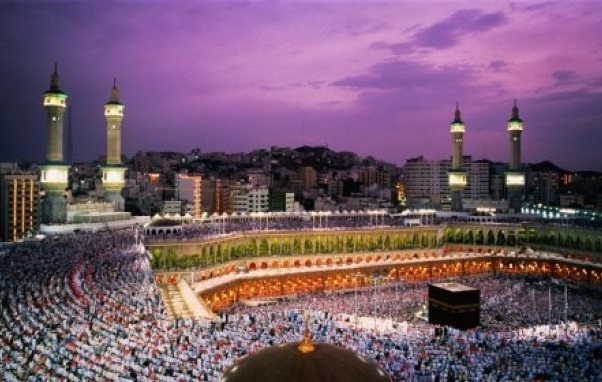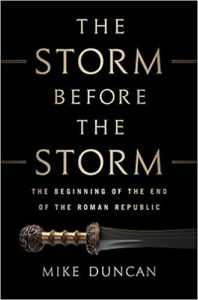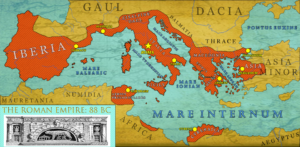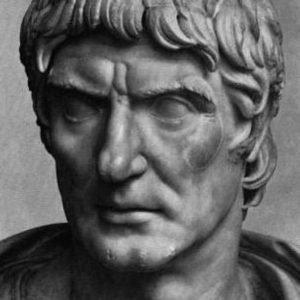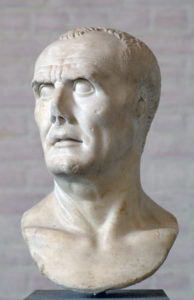The Hajj, Mecca
**
Since I posted my poem Mourning the lost Kaaba in late November 2017 — though not, I imagine, because of my poem — a report on the likely impact of climate change on the annual Hajj pilgrimage has come out from scientists at MIT and Loyola Marymount:
Kang, Pal, & Eltahir, Future Heat Stress During Muslim Pilgrimage (Hajj) Projected to Exceed “Extreme Danger” Levels
Here’s the abstract:
The Muslim pilgrimage or Hajj, which is one of the five pillars of Muslim faith, takes place outdoors in and surrounding Mecca in the Saudi Arabian desert. The U.S. National Weather Service defines an extreme danger heat stress threshold which is approximately equivalent to a wet?bulb temperature of about 29.1 °C—a combined measure of temperature and humidity. Here, based on results of simulations using an ensemble of coupled atmosphere/ocean global climate models, we project that future climate change with and without mitigation will elevate heat stress to levels that exceed this extreme danger threshold through 2020 and during the periods of 2047 to 2052 and 2079 to 2086, with increasing frequency and intensity as the century progresses. If climate change proceeds on the current trajectory or even on a trajectory with considerable mitigation, aggressive adaptation measures will be required during years of high heat stress risk.
**
That’s the science — and while Saudi Crown Prince Mohammed bin Salman told the G20 in June that the Saudis are committed to “reducing greenhouse gas emissions and adapting to the negative effects of climate change,” beliefs concerning the Prophet’s institution of the Hajj in 632 CE following on earlier Abrahamic practice may well clash with scientific claims that the Hajj may become impossible for future devout Muslims to observe.
What happens, then, when this divine command intersects with increasing temperatures that eventually render Mecca uninhabitable? How do the climate change scientists fare when they sit across the table from the ulema, the scholar-clergy of Islam?
From a Muslim point of view, we’d better climate-correct, and do so fast:
Shahin Ashraf, We must stop climate change before it makes Hajj impossible
**
The issue I’ve raised above is tightly focused on one sanctuary, one religion, one pilgrimage. Below are some other major pilgrimage sites to consider in light of climate change:
I would be interested in the cross-disciplinary exploration of the impact of climate change as understood by the scientific consensus, global migration patterns now and as expected in the coming years, and the devotional rituals and ceremonials of the various religions involved.
Large pilgrimages and religious ceremonials
This list draws text from Wikipedia and other online information sites.
Kumbh Mela:
Allahabad, India, 120 million devotees, every 12 years. The Prayag Kumbh Mela is a mela held every 12 years at Allahabad, India. The fair involves ritual bathing at Triveni Sangam, the meeting points of three rivers: the Ganga, the Yamuna and the mythical Sarasvati. The Kumbh Mela in 2013 became the largest religious gathering in the world with almost 120 million visitors.
Arba’een:
Karbala, Iraq, 30 million pilgrims annually. The Arba’een Pilgrimage is the world’s largest annual public gathering, held every year in Karbala, Iraq at the end of the 40-day mourning period following Ashura, the religious ritual for the commemoration of martyrdom of the grandson of Prophet Mohammad and the third Shia Imam, Husayn ibn Ali’s in 680. Anticipating Arba’een, or the fortieth day of the martyrdom, the pilgrims make their journey to Karbala on foot,where Husayn and his companions were martyred and beheaded by the army of Yazid I in the Battle of Karbala. The number of participants in the annual pilgrimage reached 30 million or more by 2016.
Papal Mass
Philippines, 7 million adherents, occasional. Pope Francis’ apostolic and state visit to the Philippines garnered a record breaking crowd of 7 million people. The mass conducted by the pope was the largest gathering in papal history.
Makara Jyothi
India, 5 million pilgrims annually. This pilgrim center and temple is located amidst a dense forest in the southern region of India. It was visited by over 5 million pilgrims in 2007 for a festival known as ‘Makara Jyothi,’ occurring annually on the 14 of January. Although the Sabarimala Temple, site of the Makara Jyothi celebration) draws a crowd of 50 million visitors annually, the specific day of the miraculous celestial lighting observation gathered 5 million pilgrims in 2007.
Bishwa Ijtema:
Near Dhaka, Bangladesh, 5 million pilgrims annually. The Bishwa Ijtema, meaning Global Congregation, is an annual gathering of Muslims in Tongi, by the banks of the River Turag, in the outskirts of Dhaka, Bangladesh. It is one of the largest peaceful gatherings in the world. The Ijtema is a prayer meeting spread over three days, during which attending devotees perform daily prayers while listening to scholars reciting and explaining verses from the Quran. It culminates in the Akheri Munajat, or the Final Prayer, in which millions of devotees raise their hands in front of Allah (God) and pray for world peace.The Ijtema is non-political and therefore it draws people of all persuasion. It is attended by devotees from 150 countries. Bishwa Ijtema is now the second largest Islamic gatherings with 5 million adherents
[ this is where the Hajj, with 2.3 million pilgrims annually, fits in ]
Umrah:
Mecca, size unknown, year round. The ?Umrah is an Islamic pilgrimage to Mecca, Hijaz, Saudi Arabia, performed by Muslims that can be undertaken at any time of the year, in contrast to the ?ajj which has specific dates according to the Islamic lunar calendar. It is sometimes called the ‘minor pilgrimage’ or ‘lesser pilgrimage’, the Hajj being the ‘major’ pilgrimage which is compulsory for every Muslim who can afford it. The Umrah is not compulsory but highly recommended.
Kalachakra,:
Various locations, 500,000 participants, variously. The Kalachakra is a term used in Vajrayana Buddhism that means “wheel(s) of time”. “K?lacakra” is one of many tantric teachings and esoteric practices in Tibetan Buddhism. It is an active Vajrayana tradition, and has been offered to large public audiences. The tradition combines myth and history, whereby actual historical events become an allegory for the spiritual drama within a person, drawing symbolic or allegorical lessons for inner transformation towards realizing buddha-nature. The Dalai Lama’s 33rd Kalachakra ceremony was held in Leh, Jammu and Kashmir, India from July 3 to July 12, 2014. About 150,000 devotees and 350,000 tourists were expected to participate in the festival. The Kalachakra has also been performed, eg, by Grand Master Lu Sheng-yen of the True Buddhs School, a Chinese Vajrayana group.
**
The impacts of climate change will need to be studied as they apply not only to these sites of pilgrimage, but also to holy sites in general, notably including Jerusalem, Rome, Varanasi, and Kyoto.
